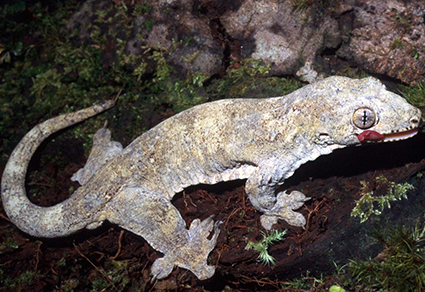Abstract
I describe four new species of Gehyra from New Guinea and immediately adjacent islands. Two of these are giant species that have long been misassigned to either G. vorax or G. membranacruralis; the other two were previously referred to G. oceanica. Each of the new species has a very circumscribed geographic distribution, with one being known from only a single island, a second from a small portion of southeastern New Guinea and immediately adjacent islands, a third from a small archipelago, and the fourth from foothill forest along the northern versant of eastern New Guinea. Three of these species are found only in the Milne Bay Region of southeastern Papua New Guinea, a region previously identified as having a globally high density of narrow-range endemic reptile and amphibian species. These species provide further extension of that pattern by increasing the number of known endemic herpetofaunal species from that small region to 165. Variation in subcaudal shape is taxonomically useful in Gehyra, but its character-state coding must rely on original tails because aberrant development of subcaudals in some regenerated tails could lead to mischaracterization of this feature.
References
- Bauer, A.M. & Henle, K. (1994) Familia Gekkonidae (Reptilia, Sauria). Part I. Australia and Oceania. Das Tierreich, 109, 1–306. https://doi.org/10.1515/9783110885958
- Beckon, W.N. (1990) Patterns of colonization and distribution, the species-area relation, and other aspects of the biogeography of island vertebrates, with particular reference to the Fiji Archipelago. PhD dissertation, University of California, Davis, California, 394 pp.
- Beckon, W.N. (1992) The giant Pacific geckos of the genus Gehyra: morphological variation, distribution, and biogeography. Copeia, 1992, 443–460. https://doi.org/10.2307/1446204
- Brongersma, L.D. (1934) Contributions to Indo-Australian herpetology. Zoologische Mededeelingen, 17, 161–251.
- de Rooij, N. (1915) The reptiles of the Indo-Australian Archipelago. I. Lacertilia, Chelonia, Emydosauria. E.J. Brill, Leiden, 384 pp. https://doi.org/10.5962/bhl.title.10610
- Fisher, R.N. (1997) Dispersal and evolution of the Pacific Basin gekkonid lizards Gehyra oceanica and Gehyra mutilata. Evolution, 51, 906–921. https://doi.org/10.2307/2411165
- Flecks, M., Schmitz, A., Böhme, W., Henkel, F.W. & Ineich, I. (2012) A new species of Gehyra Gray, 1834 (Squamata, Gekkonidae) from the Loyalty Islands and Vanuatu, and phylogenetic relationships in the genus Gehyra in Melanesia. Zoosystema, 34, 203–221. https://doi.org/10.5252/z2012n2a1
- Goldberg, S.R., Bursey, C.R. & Kraus, F. (2010) Helminths of ten species of geckos (Squamata: Gekkonidae) from Papua New Guinea, with comparisons between immigrant and endemic geckos. Pacific Science, 64, 131–139. https://doi.org/10.2984/64.1.131
- Heinicke, M.P., Greenbaum, E., Jackman, V & Bauer, A.M. (2011) Phylogeny of a trans-Wallacean radiation (Squamata, Gekkonidae, Gehyra) supports a single early colonization of Australia. Zoologica Scripta, 40, 584–602. https://doi.org/10.1111/j.1463-6409.2011.00495.x
- King, M. & Horner, P. (1989) Karyotypic evolution in Gehyra (Gekkonidae: Reptilia). V. A new species from Papua New Guinea and the distribution and morphometrics of Gehyra oceanica (Lesson). The Beagle, Records of the Northern Territory Museum of Arts and Sciences, 6, 169–178. https://doi.org/10.5962/p.262847
- King, M., Sadlier, R.A. & Horner, P. (1989) A note on the status of Gehyra baliola (Duméril and Duméril, 1851) in Australia. The Beagle, Records of the Northern Territory Museum of Arts and Sciences, 6, 163–167. https://doi.org/10.5962/p.262846
- Kraus, F. (2021) A herpetofauna with dramatic endemism signals an overlooked biodiversity hotspot. Biodiversity and Conservation, 30, 3167–3183. https://doi.org/10.1007/s10531-021-02242-3
- Kraus, F. (2023) A revision of Gerrhopilus inornatus (Squamata: Gerrhopilidae) reveals a multi-species complex. Zootaxa, 5231 (1), 1–23. https://doi.org/10.11646/zootaxa.5231.1.1
- Kraus, F. & Shea, G. (2005) Additional reptile and amphibian range extensions for Milne Bay Province, Papua New Guinea. Herpetological Review, 36, 471–473.
- Oliver, P.M., Ashman, L.G., Bank, S., Laver, R.J., Pratt, R.C., Tedeschi, L.G. & Moritz, C.C. (2019) On and off the rocks: persistence and ecological diversification in a tropical Australian lizard radiation. BMC Evolutionary Biology, 19, 1–15. https://doi.org/10.1186/s12862-019-1408-1
- Oliver, P.M., Clegg, J.R., Fisher, R.N., Richards, S.J., Taylor, P.N. & Jocque, M.M.T. (2016) A new biogeographically distinct giant gecko (Gehyra: Gekkonidae: Reptilia) from the East Melanesian Islands. Zootaxa, 4208 (1), 61–76. https://doi.org/10.11646/zootaxa.4208.1.3
- Oliver, P.M., Sistrom, M., Tjaturadi, B., Krey, K. & Richards, S. (2010) On the status and relationships of the gecko species Gehyra barea Kopstein 1926, with description of new specimens and a range extension. Zootaxa, 2354 (1), 45–55. https://doi.org/10.11646/zootaxa.2354.1.4
- Rocha, S., Ineich, I. & Harris, D.J. (2009) Cryptic variation and recent bipolar range expansion within the Stump-toed Gecko Gehyra mutilata across Indian and Pacific ocean islands. Contributions to Zoology, 78, 1–8. https://doi.org/10.1163/18759866-07801001
- Sistrom, M.J., Hutchinson, M.N., Hutchinson, R.G. & Donnellan, S.C. (2009) Molecular phylogeny of Australian Gehyra (Squamata: Gekkonidae) and taxonomic revision of Gehyra variegata in south-eastern Australia. Zootaxa, 2277 (1), 14–32. https://doi.org/10.11646/zootaxa.2277.1.2
- Skipwith, P.L. & Oliver, P.M. (2014) A new Gehyra (Gekkonidae: Reptilia) from New Guinea with unique caudal scalation. Zootaxa, 3827 (1), 57–66. https://doi.org/10.11646/zootaxa.3827.1.5
- Slavenko, A., Tamar, K., Tallowin, O.J.S., Kraus, F., Allison, A., Carranza, S. & Meiri, S. (2022) Revision of the montane New Guinean skink genus Lobulia (Squamata: Scincidae), with the description of four new genera and nine new species. Zoological Journal of the Linnaean Society, 195, 220–278. https://doi.org/10.1093/zoolinnean/zlab052
- Tonione, M.A., Fisher, R.N., Zhu, C. & Moritz, C. (2016) Deep divergence and structure in the tropical oceanic Pacific: a multilocus phylogeography of a widespread gekkonid lizard (Squamata: Gekkonidae: Gehyra oceanica). Journal of Biogeography, 43, 268–278. https://doi.org/10.1111/jbi.12645
- Uetz, P., Freed, P., Aguilar, R., Reyes, F. & Hošek, J. (Eds.) (2023) The Reptile Database, http://www.reptile-database.org. (accessed 26 December 2023)
- Zug, G.R. (2013) Reptiles and amphibians of the Pacific islands: a comprehensive guide. University of California Press, Berkeley, California, 306 pp. https://doi.org/10.1525/9780520955400


